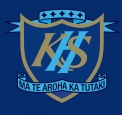Kaiapoi High School is a state co-educational secondary school located in Kaiapoi, in the Waimakariri District of New Zealand's South Island. The school serves 1,080 students from Years 9 to 13 (approx. ages 12 to 18) as of February 2024.[1]
| Kaiapoi High School | |
|---|---|
 | |
| Address | |
 | |
| Coordinates | 43°23′16″S 172°38′45″E / 43.3879°S 172.6458°E |
| Information | |
| Funding type | State |
| Motto | Ma Te Aroha Ka Tutaki (Through caring, concern and support for others, all things are possible) |
| Opened | February 1972 |
| Ministry of Education Institution no. | 314 |
| Principal | Jason Reid |
| Years offered | 9–13 |
| Gender | Co-educational |
| School roll | 1,080[1] (February 2024) |
| Socio-economic decile | 7O[2] |
| Website | www |
History edit
The Kaiapoi Borough Council first approached the government about establishing a school in the town in 1954.[3] The Department of Education approved the purchase of the 20.5-acre (8.3 ha) site on Ohoka Road in September 1961.[4]
The school opened in February 1972.[5] Like many New Zealand state secondary schools built in the 1970s, Kaiapoi High School was built to the S68 standard design, characterised by single-storey classroom blocks of masonry construction, low-pitched roofs with protruding clerestory windows, and internal open courtyards.[6] Other schools using this design in the wider Canterbury area include Hornby High School and Ashburton College.
Enrolment edit
Kaiapoi High School serves the coastal Waimakariri District, including the towns of Kaiapoi, Woodend, Pegasus, Waikuku, and the surrounding rural area west to Swannanoa. It also serves the rural northeastern part of Christchurch City as far south as the Styx River, including Kainga, Brooklands, Spencerville.
At the April 2014 Education Review Office (ERO) review of the school, Kaiapoi High School had 587 students, including 24 international students. There were slightly more male students (51%) than female students. 79% of students identified as New Zealand European (Pākehā), 14% identified as Māori, and 7% identified as another ethnicity.[7]
Kaiapoi High School has a socio-economic decile of 7 (funding step O), meaning it draws its school community from areas of moderately-low socio-economic disadvantage when compared to other New Zealand schools. This changed from decile 5 (funding step M) at the beginning of 2015, as part of the nationwide review of deciles following the following the 2013 census.[8]
Karanga Mai Young Parents' College edit
Karanga Mai Young Parents' College is a teen parent unit attached to Kaiapoi High School designed to assist teenage parents (and expectant parents) in gaining a secondary school education. Opened in 1992, it was the first teen parent unit in the South Island, and only the second unit in New Zealand.[9][10]
Notable alumni edit
- Jenni Adams – New Zealand physicist
References edit
- ^ a b "New Zealand Schools Directory". New Zealand Ministry of Education. Retrieved 14 March 2024.
- ^ "Decile Change 2014 to 2015 for State & State Integrated Schools". Ministry of Education. Retrieved 12 February 2015.
- ^ "HIGH SCHOOL AT KAIAPOI - Minister Promises Inquiry". The Press. 20 March 1957. p. 6.
- ^ "KAIAPOI HIGH SCHOOL - Land Purchase Approved". The Press. 18 September 1961. p. 12.
- ^ "Kaiapoi High School Charter 2012" (PDF). Kaiapoi High School Board of Trustees. Archived from the original (PDF) on 3 December 2013. Retrieved 29 November 2013.
- ^ "Catalogue of Standard School Building Types" (PDF). Christchurch: Ministry of Education. August 2013. Retrieved 10 July 2014.
- ^ "Kaiapoi High School Education Review". Education Review Office. 13 June 2014. Archived from the original on 6 November 2014. Retrieved 6 November 2014.
- ^ "How has the decile changed at your school?". Stuff.co.nz. 26 November 2014. Retrieved 26 November 2014.
- ^ "Karanga Mai Young Parents College Education Review". New Zealand Education Review Office. 23 October 2013. Archived from the original on 3 December 2013. Retrieved 29 November 2013.
- ^ "Karanga Mai Young Parents' College & Support". Kaiapoi High School. Archived from the original on 3 December 2013. Retrieved 29 November 2013.